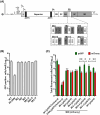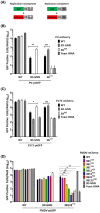Functional advantages of triplication of the 3B coding region of the FMDV genome
- PMID: 33230899
- PMCID: PMC7894486
- DOI: 10.1096/fj.202001473RR
Functional advantages of triplication of the 3B coding region of the FMDV genome
Erratum in
-
Erratum.FASEB J. 2021 Feb;35(2):e21294. doi: 10.1096/fsb2.21294. FASEB J. 2021. PMID: 34162170 Free PMC article. No abstract available.
Abstract
For gene duplication to be maintained, particularly in the small genomes of RNA viruses, this should offer some advantages. We have investigated the functions of a small protein termed VPg or 3B, which acts as a primer in the replication of foot-and-mouth disease virus (FMDV). Many related picornaviruses encode a single copy but uniquely the FMDV genome includes three (nonidentical) copies of the 3B coding region. Using sub-genomic replicons incorporating nonfunctional 3Bs and 3B fusion products in competition and complementation assays, we investigated the contributions of individual 3Bs to replication and the structural requirements for functionality. We showed that a free N-terminus is required for 3B to function as a primer and although a single 3B can support genome replication, additional copies provide a competitive advantage. However, a fourth copy confers no further advantage. Furthermore, we find that a minimum of two 3Bs is necessary for trans replication of FMDV replicons, which is unlike other picornaviruses where a single 3B can be used for both cis and trans replication. Our data are consistent with a model in which 3B copy number expansion within the FMDV genome has allowed evolution of separate cis and trans acting functions, providing selective pressure to maintain multiple copies of 3B.
Keywords: 3B; FMDV; evolution; gene duplication; picornavirus; trans-complementation.
© 2020 The Authors. The FASEB Journal published by Wiley Periodicals LLC on behalf of Federation of American Societies for Experimental Biology.
Conflict of interest statement
The authors declare no conflict of interests.
Figures





Similar articles
-
Genetic economy in picornaviruses: Foot-and-mouth disease virus replication exploits alternative precursor cleavage pathways.PLoS Pathog. 2017 Oct 2;13(10):e1006666. doi: 10.1371/journal.ppat.1006666. eCollection 2017 Oct. PLoS Pathog. 2017. PMID: 28968463 Free PMC article.
-
Domain disruptions of individual 3B proteins of foot-and-mouth disease virus do not alter growth in cell culture or virulence in cattle.Virology. 2010 Sep 15;405(1):149-56. doi: 10.1016/j.virol.2010.05.036. Epub 2010 Jun 30. Virology. 2010. PMID: 20580394
-
Deletion mutants of VPg reveal new cytopathology determinants in a picornavirus.PLoS One. 2010 May 20;5(5):e10735. doi: 10.1371/journal.pone.0010735. PLoS One. 2010. PMID: 20505767 Free PMC article.
-
Structural insights into replication initiation and elongation processes by the FMDV RNA-dependent RNA polymerase.Curr Opin Struct Biol. 2009 Dec;19(6):752-8. doi: 10.1016/j.sbi.2009.10.016. Epub 2009 Nov 13. Curr Opin Struct Biol. 2009. PMID: 19914060 Review.
-
Foot-and-mouth disease virus.Comp Immunol Microbiol Infect Dis. 2002 Oct;25(5-6):297-308. doi: 10.1016/s0147-9571(02)00027-9. Comp Immunol Microbiol Infect Dis. 2002. PMID: 12365806 Review.
Cited by
-
Infection and protection responses of deletion mutants of non-structural proteins of foot-and-mouth disease virus serotype Asia1 in guinea pigs.Appl Microbiol Biotechnol. 2022 Jan;106(1):273-286. doi: 10.1007/s00253-021-11692-2. Epub 2021 Dec 10. Appl Microbiol Biotechnol. 2022. PMID: 34889988
-
Development of enterovirus trans-encapsidation assays as tools to understand viral entry.bioRxiv [Preprint]. 2025 Jul 11:2025.07.11.664324. doi: 10.1101/2025.07.11.664324. bioRxiv. 2025. PMID: 40672215 Free PMC article. Preprint.
-
Multiple Viral Protein Genome-Linked Proteins Compensate for Viral Translation in a Positive-Sense Single-Stranded RNA Virus Infection.J Virol. 2022 Sep 14;96(17):e0069922. doi: 10.1128/jvi.00699-22. Epub 2022 Aug 22. J Virol. 2022. PMID: 35993738 Free PMC article.
-
The RNA pseudoknots in foot-and-mouth disease virus are dispensable for genome replication, but essential for the production of infectious virus.PLoS Pathog. 2022 Jun 6;18(6):e1010589. doi: 10.1371/journal.ppat.1010589. eCollection 2022 Jun. PLoS Pathog. 2022. PMID: 35666744 Free PMC article.
-
Dual role of the foot-and-mouth disease virus 3B1 protein in the replication complex: As protein primer and as an essential component to recruit 3Dpol to membranes.PLoS Pathog. 2023 May 1;19(5):e1011373. doi: 10.1371/journal.ppat.1011373. eCollection 2023 May. PLoS Pathog. 2023. PMID: 37126532 Free PMC article.
References
-
- Valli A, López‐Moya JJ, García JA. Recombination and gene duplication in the evolutionary diversification of P1 proteins in the family Potyviridae. J Gen Virol. 2007;88:1016‐1028. - PubMed
-
- Magadum S, Banerjee U, Murugan P, Gangapur D, Ravikesavan R. Gene duplication as a major force in evolution. J Genet. 2013;92:155‐161. - PubMed
Publication types
MeSH terms
Substances
Grants and funding
- 102174/B/13/Z/WT_/Wellcome Trust/United Kingdom
- BB/K003801/1/BB_/Biotechnology and Biological Sciences Research Council/United Kingdom
- BB/P001459/1/BB_/Biotechnology and Biological Sciences Research Council/United Kingdom
- BB/F01614X/1/BB_/Biotechnology and Biological Sciences Research Council/United Kingdom
- WT_/Wellcome Trust/United Kingdom
LinkOut - more resources
Full Text Sources

